2. 黑龙江省水土保持重点实验室, 150070, 哈尔滨
-
项目名称
- 黑龙江省自然基金项目"黑土区切沟变化特征对融雪侵蚀的响应"(LH2020D018)
-
第一作者简介
- 侯淑艳(1980—), 女, 博士, 高级工程师。主要研究方向: 水土保持。E-mail: houshuyan2007@126.com
-
文章历史
-
收稿日期:2021-11-30
修回日期:2022-04-08
2. 黑龙江省水土保持重点实验室, 150070, 哈尔滨
2. Heilongjiang Key Laboratory for Soil and Water Conservation, 150070, Harbin, China
中国东北拥有珍贵的黑土资源,是世界仅有的四大黑土区之一。东北黑土区因为其独特的地形地貌、坡耕地缓坡长坡等特点,加之东北春夏之交期间,植被覆盖率低,降雨集中且多为暴雨,因此黑土区坡耕地成为东北黑土区水土流失的主要策源地[1-2]。降雨径流带走了坡耕地表层土壤,使黑土理化性状降低,土地生产力下降。据统计,黑土区坡耕地水土流失导致的粮食减产总量高达108亿kg[3-4]。坡面降雨侵蚀的发生与降雨、地形、下垫面条件等因素密切相关。降雨强度、历时、雨型、降雨量等参数都是造成坡面侵蚀产生的主要因素;坡长、坡向、坡度、坡型等地形因子是决定径流产生、流速大小、破坏土壤稳定性的外营力重要参数;下垫面条件是影响土壤流失量的重要因素。因此,改变地面条件,有效阻控坡面产流产沙是保持水土的重要措施。东北黑土区的水土保持措施类型根据坡度不同,所采取的治理措施也不同,坡面主要有等高耕作、地埂植物带、水平梯田、坡式梯田等。植被盖度、增加地面覆盖等都具有较好的保持水土效果。相关的水土保持措施在近几年国家大力治理黑土地的水土保持重点治理工程中得以应用,并取得了良好的效果。因此,因地制宜布设水土保持措施,分析水土保持措施减沙减水效益,科学认识水土保持措施,对于流域水沙变化及生态环境的改善具有重要意义[5]。
1 研究区概况试验地为黑龙江省水利科学研究院克山水土保持试验站粮食沟观测场,位于黑龙江省克山县古北乡境内,距克山县城5 km,克北公路西侧,地理坐标为E 125°49′19″、N 48°03′20″。多年平均降雨量为479.4 mm、多年平均径流深51 mm、年均温度1.1 ℃、≥10 ℃积温2 380 ℃、无霜期122 d。地貌类型为丘陵漫岗、波状起伏。植被类型为针叶阔叶林,主要农作物玉米(Zea mays)、大豆(Glycine max)、高粱(Sorghum bicolor),土壤类型为黑土。
2 材料与方法 2.1 试验设计本实验根据东北黑土区典型坡度设置,分别设置3°、5°、8°坡度径流小区,每个坡度分别设置不同水土保持措施及对照。3°坡下设置等高耕作、顺坡垄作、裸地小区3种类型,每个类型2次重复;5°坡下设置地埂植物带、顺坡垄作、裸地小区3种类型,每个类型2次重复;8°坡下设置水平梯田小区、顺坡垄作、裸地小区,每个类型2次重复。所有顺坡垄作小区平地起垄,种植作物,裸地小区不耕种,生长杂草人工拔除。其余小区种植植物为大豆。小区设置见表 1。
| 表 1 试验小区基本情况 Tab. 1 Basic information of experimental plot |
2019年4月对试验小区整地,垄距70 cm,采取一次性施肥措施,与当地农耕施肥一致,施肥纯量为180 kg/hm2。5月9日分别对整地的12个小区种植大豆,种植密度为9.5万株/hm2,株行距为15 cm×70 cm。6月13进行1次中耕,9月23日收获,测粮食和秸秆产量。
2.2 样品采集与指标测定 2.2.1 样品采集使用米尺垂直放入桶中至桶底,分4次在不同点测量水位高度,填入记录表中,计算径流量;用木棍搅动分(集)流桶的泥水使之混合均匀,随后迅速采集水样,盛满采样杯,倒入小塑料桶内。再继续搅匀水样,盛满采样杯,重复3次。再将小塑料桶内的水样搅匀,迅速用采样杯取500 mL水样装入对应的采样瓶,盖紧瓶盖,室内过滤、烘干、称量,计算含沙量。
2.2.2 样品指标测定采用SL-2型虹吸式雨量器用以记录降雨量;径流量及土壤流失量的测定详见文献[6]。
试验数据采用Excel进行整理分析。
3 结果与分析 3.1 不同水土保持措施对黑土坡耕地土壤流失量的影响选择18个小区全部产流的13次降雨,分析不同降雨情况下,不同水土保持措施对黑土坡耕地土壤流失量的影响,详见表 2。13次降雨总量为450.6 mm,达到全年总降雨量的64.3%,因此也是土壤流失产生的主要时期。通过表 2可以明显看出,不同降雨场次中,3°、5°和8°坡度下土壤流失量规律基本为A1 < A2 < A3、B1 < B2 < B3、C1 < C2 < C3;说明不同坡度下,等高耕作、地埂植物带及水平梯田能够明显减少土壤流失。
| 表 2 不同水土保持措施下平均土壤流失量 Tab. 2 Average soil loss under different soil and water conservation measures |
等高耕作、地埂植物带、梯田等水土保持耕作措施一直以来都是干旱、半干旱地区广泛应用的保护性耕作措施之一,能够显著增加降雨入渗,拦蓄径流,有效减少坡面水土流失[7]。从表 3中可以明显看出A1、A2、A3不同措施的3个小区中,径流量与土壤流失量变化差异显著,等高耕作的A1小区全年径流量仅为10.42 mm,土壤流失量184.70 kg/hm2,与A2、A3相比径流量减少率分别为95.34%和96.35%,土壤流失量分别减少95.49%和97.42%。B1、B2、B3不同措施的3个小区中,径流量与土壤流失量同样变化差异显著,地埂植物带的B1小区全年径流量仅为18.22 mm,土壤流失量323.60 kg/hm2,与B2、B3相比径流量减少率分别为86.74%和89.49%,土壤流失量分别减少93.04%和96.34%。C1、C2、C3不同措施的3个小区中,水平梯田的C1小区全年径流量为43.83 mm,土壤流失量1 668 kg/hm2,与C2、C3相比径流量减少率分别为55.63%和72.57%;土壤流失量分别减少47.71%和85.00%。3°、5°、8°坡度顺坡垄作小区与裸地小区相比径流量减少率分别为18.3%、21.7%、38.2%,土壤流失量减少率分别为42.9%、47.5%、63.9%。通过以上分析可以明显看出,等高耕作、地埂植物带、水平梯田显著减少了坡耕地产流产沙量。白怡婧等[8]的研究表明与顺坡平作相比,横坡垄作、秸秆还田、等高植物篱等保护性耕作能有效降低坡耕地地表径流。等高耕作与直线坡相比,径流量和产沙量分别减少38.2%和65.6%[9]。不同降雨量下,保护性耕作各处理小区径流量和产沙量均少于对照[10]。耕作方式能够消减坡面径流量及产沙量,但等高耕作的消减作用最大[11],这与本文的研究结果一致。
| 表 3 不同水土保持措施对径流阻控率的影响 Tab. 3 Influence of different soil and water conservation measures on runoff resistance control rate |
大豆生长的观测期内(5月9日—9月23日),共有87次降雨,降雨总量701.3 mm。最大日降水量为71.2 mm,最大月降水量为8月,降水量为264.1 mm,占全年降水总量的38%。87次降雨中,有26次坡面小区有不同程度的产流,其中13次18个小区全产流。同一坡度不同水土保持措施产沙产流量与降雨量关系见图 1~6;图 1、3和5中,3°坡试验小区只A2小区26次降雨产流,A1等高耕作小区8月中旬后期由于降雨量减少,几乎没产流。对于径流量与降雨量进行线性拟合,A1、A2、A3拟合方程中R2分别为0.195 3、0.716 2、0.667 8。5°坡试验小区顺坡垄作及裸地小区均在26次产流降雨中产流,B1小区径流产流特征与A1小区相似,8月中后期几乎没有径流产生。5°坡试验小区B1、B2和B3径流量与降雨量拟合方程R2分别为0.544 4、0.568 6和0.637 3。8°坡试验小区中,全年26次产流降雨中,C1产流17次,C3小区26次降雨全产流。C1、C2和C3径流量与降雨拟合方程中R2分别为0.535 7、0.815 6和0.480 6。通过以上分析表明:3个不同坡度小区径流量与降雨量呈显著的线性关系,说明降雨量是坡面径流量产生的主要因素,但由于等高耕作、地埂植物带及水平梯田水土保持措施的布设,致使3小区产流次数少,径流量小,说明水土保持措施对于降雨径流具有拦阻作用。李建明等[12]综合分析了试验小区2年的径流量,结果显示,植物措施与工程措施的减流率均大于90%,耕作措施的减流率大于76%。
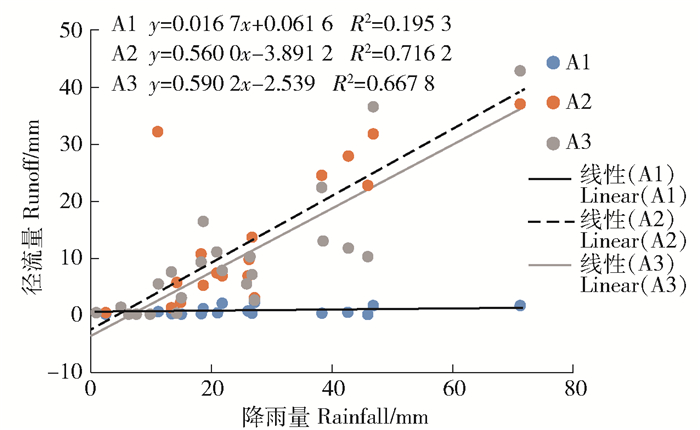
|
图 1 3°坡不同水土保持措施径流量与降雨量的关系 Fig. 1 Relationship between runoff and rainfall on 3° slope under different soil and water conservation measures |
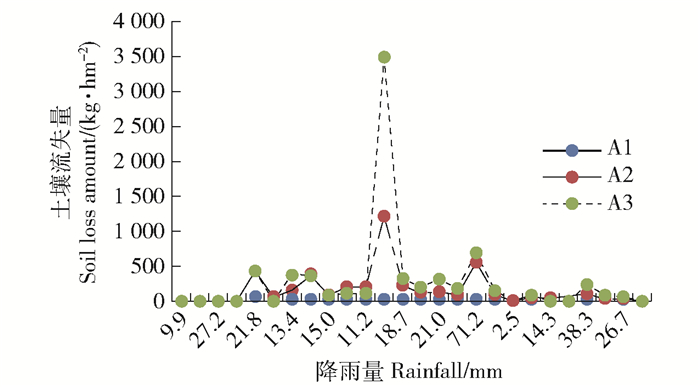
|
图 2 3°坡不同水土保持措施土壤流失量与降雨量的关系 Fig. 2 Relationship between soil loss amount and rainfall on 3° slope under different soil and water conservation measures |
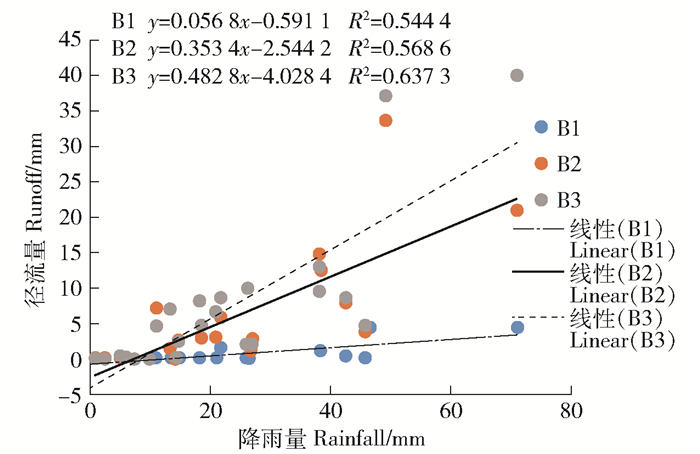
|
图 3 5°坡不同水土保持措施径流量与降雨量的关系 Fig. 3 Relationship between runoff and rainfall on 5° slope under different soil and water conservation measures |
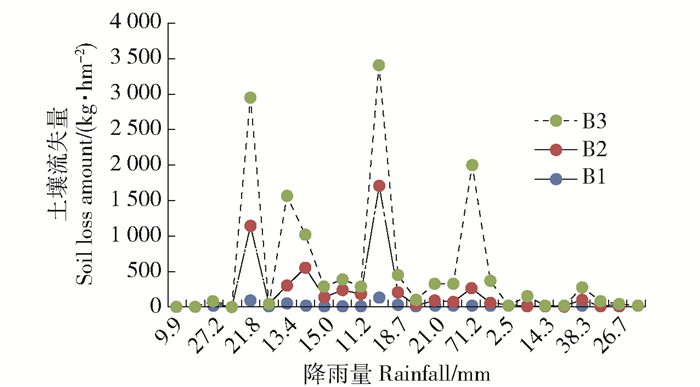
|
图 4 5°坡不同水土保持措施土壤流失量与降雨量的关系 Fig. 4 Relationship between soil loss amount and rainfall on 5° slope under different soil and water conservation measures |
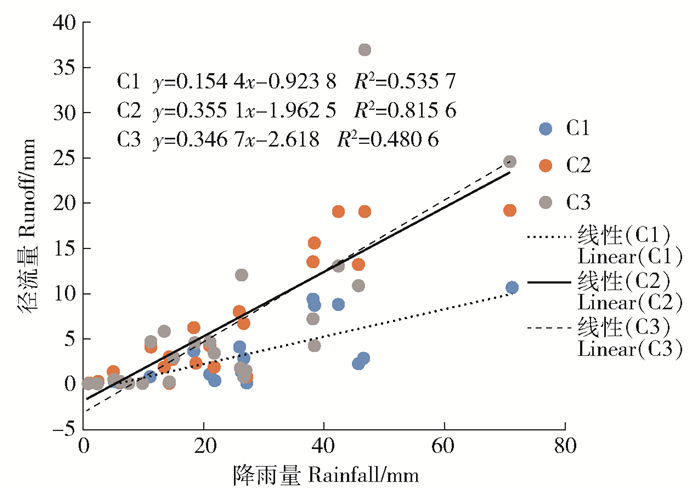
|
图 5 8°坡不同水土保持措施径流量与降雨量的关系 Fig. 5 Relationship between runoff and rainfall on 8° slope under different soil and water conservation measures |
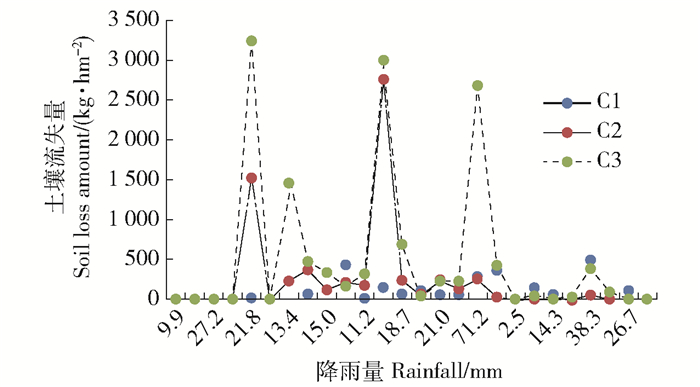
|
图 6 8°坡不同水土保持措施土壤流失量与降雨量的关系 Fig. 6 Relationship between soil loss amount and rainfall on 8° slope under different soil and water conservation measures |
图 2、4和6中,3个不同坡度小区的不同降雨量对土壤流失量的影响与径流量关系总体规律相近,高降雨量下均有不同土壤流失量的峰值出现,8月中下旬之后流失量随降雨量变化不大。3个坡度小区均在降雨量46.8 mm时出现最大流失量峰值,而年度最大降雨量71.2 mm时流失量不高,主要原因可能是6月中下旬对各小区进行了中耕,主要方法为锄头铲除垄上及垄沟内杂草,动土厚度5~10 cm,重新起垄,导致小区内表层土壤疏松,破坏地面表层抗蚀力,加大土壤流失。设置水土保持措施的观测小区A1、B1、C1土壤流失量随降雨量变化不大,A2、B2、C2次之,裸地小区流失量最高,说明水土保持措施显著降低坡耕地产沙产流。
3.4 不同坡度条件相同耕作方式对黑土坡耕地产流产沙的影响图 7~10发现,顺坡垄作与裸地3小区径流量与土壤流失量大小均为A < B < C,说明相同耕作措施下,坡耕地产流产沙量与坡度大小呈正比。坡度一直就是影响水土流失的重要因素之一,耕作土地的有效蓄水能力会随着坡度的增加而减弱,强降雨时,坡度大会大大增加地表径流[13]。相关研究[14-15]表明,地表径流和侵蚀量会随着坡度的增加而增大,与本研究的结论一致。顺坡垄作的A2、B2、C2径流量与土壤流失量均低于相同坡度下的裸地小区,说明与裸地相比,顺坡垄作有助于阻控坡耕地径流量与土壤流失量。沟垄耕作改变了原地表形态,有沟有垄的微地形变化增加了地表的受雨面积,减少了单位受雨量,加之种植作物的覆盖,从而使径流量与土壤流失量显著小于裸地[16]。
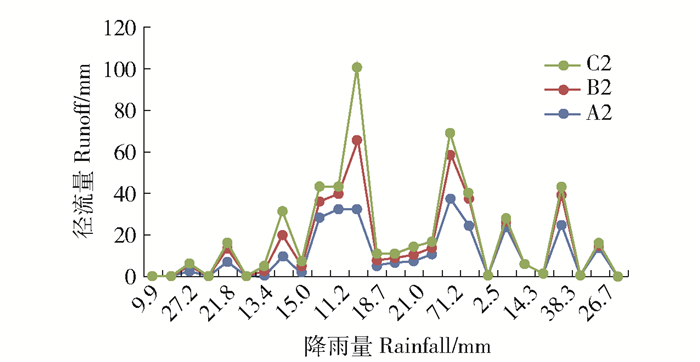
|
图 7 顺坡垄作小区径流量与降雨量的关系 Fig. 7 Relationship between runoff and rainfall in ridged areas along slope |
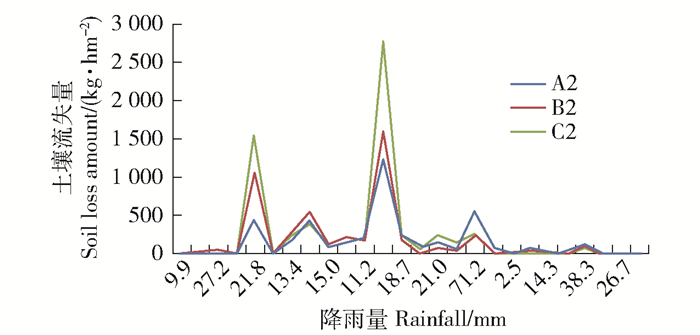
|
图 8 顺坡垄作小区土壤流失量与降雨量的关系 Fig. 8 Relationship between soil loss amount and rainfall in ridged areas along slope |
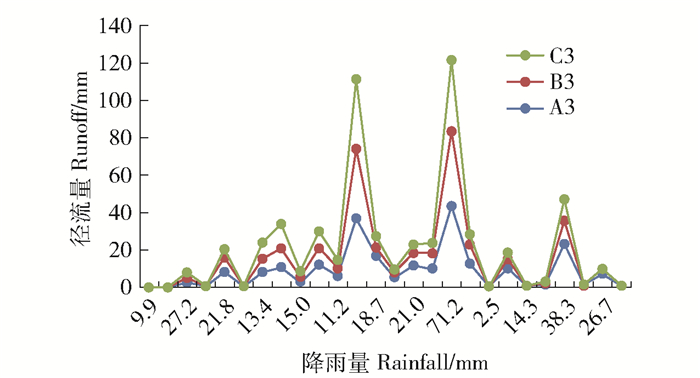
|
图 9 裸地小区径流量与降雨量的关系 Fig. 9 Relationship between runoff and rainfall in loss and bare land area |
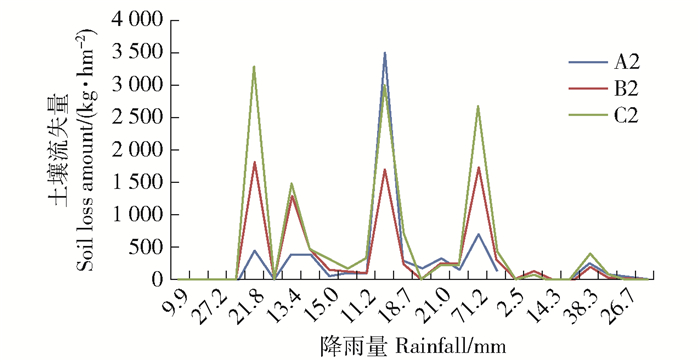
|
图 10 裸地小区土壤流失量与降雨量的关系 Fig. 10 Relationship between the soil loss amount and rainfall in bare land area |
在自然降雨条件下,通过对典型黑土区径流小区的采样分析表明:3个不同坡度小区径流量与降雨量呈显著的线性关系,等高耕作、地埂植物带及水平梯田水土保持措施的布设,显著减少了土壤流失量、产流次数,降低了径流量。
3°坡等高耕作措施比顺坡垄作、裸地相比径流量减少率分别为95.34%和96.35%;土壤流失量分别减少95.49%、97.42%;5°坡地埂植物带措施与顺坡垄作、裸地相比径流量减少率分别为86.74%、89.49%;土壤流失量分别减少93.04%、96.34%。8°坡水平梯田与顺坡垄作、裸地相比径流量减少率分别为55.63%、72.57%;土壤流失量分别减少47.71%、85.00%。3°、5°和8°坡度顺坡垄作小区与裸地小区相比径流量减少率分别为18.3%、21.7%和38.2%;土壤流失量减少率分别为42.9%、47.5%和63.9%。
3°、5°、8°小区顺坡垄作与裸地的径流量与土壤流失量大小均以8°小区最大。3个坡度下的顺坡垄作小区径流量与土壤流失量均低于相同坡度下的裸地小区。
5 讨论黑土区坡耕地下,水土保持措施能够显著减少坡面产流产沙,减少水土流失。有效的水土保持综合措施可显著减少地表径流,减少土壤侵蚀。与耕作措施比较,植物措施与工程措施具有更显著的减流减沙效果, 起到了较好的保水作用[12, 17]。秦隆宇[18]研究认为水土保持措施可对降雨径流发挥良好的拦蓄作用。与本研究结论一致。李振兴[19]对湫水河流域水沙变化研究表明,水土保持项目的实施对于河川径流量和输沙量的减沙发挥了显著作用。
坡度的大小能够显著影响坡耕地水土流失量和径流量。坡度对坡耕地水土流失的影响主要是在相同的降雨条件下,坡度越大,因其地势的高差而引起的重力作用越大,从而使相同条件下的径流加速,土壤流失量加大[20];相同的降雨因素下,坡面径流小区的径流量、产沙量与坡度大小呈正比[21],与本研究结果一致。赵龙山等[22]的研究认为产流量在大于15°坡时呈递增趋势,产沙量在5°~10°坡之间变化不明显。这一结论与本研究中关于相同耕作措施下,坡耕地产流产沙量与坡度大小呈正比的结论不一致。降雨产流产沙取决于土壤理化性质、降雨强度、历时等多方面因素,因此各种条件下产生的产沙量情况还有待于进一步研究探讨。
| [1] |
申聪颖. 两种粮草种植方式对不同坡度暗棕壤水土保持效应的影响[D]. 长春: 吉林农业大学, 2019: 3 SHEN Congying. Effects of two cropping patterns on soil and water conservation in dark brown soil with different slopes[D]. Changchun: Jilin Agricultural University, 2019: 3. |
| [2] |
张秋萍, 土壤表面固定剂研制及其对黑土区水土流失阻控效果初步研究[D]. 长春: 吉林农业大学, 2019: 5. ZHANG Qiuping. Preliminary study on development of soil surface fixator and its effect on soil erosion control in black soil area[D]. Changchun: Jilin Agricultural University, 2019: 5 |
| [3] |
冯志珍, 郑粉莉, 易祎. 薄层黑土微生物生物量碳氮对土壤侵蚀-沉积的响应[J]. 土壤学报, 2017, 54(6): 1332. FENG Zhizhen, ZHENG Fenli, YI Wei. Response of microbial biomass carbon and nitrogen to soil erosion-deposition in thin black soil[J]. Acta Pedologica Sinica, 2017, 54(6): 1332. |
| [4] |
闫百兴, 杨育红, 刘兴土, 等. 东北黑土区土壤侵蚀现状与演变趋势[J]. 中国水土保持, 2008(12): 26. YAN Baixing, YANG Yuhong, LIU Xingtu, et al. Present situation and evolution trend of soil erosion in black soil region of northeast China[J]. Soil and Water Conservation in China, 2008(12): 26. DOI:10.3969/j.issn.1000-0941.2008.12.009 |
| [5] |
王佳琦. 辽宁省典型流域水土保持措施减水减沙效益分析[D]. 沈阳: 沈阳农业大学, 2018: 10. WANG Jiaqi. Benefit analysis of water and sediment reduction by soil and water conservation measures in typical watershed of Liaoning province[D]. Shenyang: Shenyang Agricultural University, 2018: 10 |
| [6] |
李飞, 韩兴, 马秀兰, 等. 秸秆覆盖对东北黑土区坡耕地产流产沙及氮磷流失的阻控[J]. 水土保持学报, 2020, 34(4): 37. LI Fei, HAN Xing, MA Xiulan, et al. Control of straw mulching on sediment yield and nitrogen and phosphorus loss of sloping farmland in black soil region of Northeast China[J]. Journal of Soil and Water Conservation, 2020, 34(4): 37. |
| [7] |
MA Qian, YU Xingxiu, LIU Qianjin, et al. Comparative study on dissolved N and P loss and eutrophication risk in runoff water in contour and down-slope[J]. Journal of Food Agriculture & Environment, 2010, 8(3): 1042. |
| [8] |
白怡婧, 李渝, 黄兴成, 等. 保护性耕作对黄壤坡耕地水土流失及作物产流的影响[J]. 土壤学报, 2017, 54(6): 1332. BAI Yijing, LI Yu, HUANG Xingcheng, et al. Effects of conservation tillage on soil erosion and crop runoff in sloping yellow soil[J]. Acta Pedologica Sinica, 2017, 54(6): 1332. |
| [9] |
林超文, 陈一兵, 黄晶晶, 等. 不同耕作方式和雨强对紫色土养分流失的影响[J]. 中国农业科学, 2007, 40(10): 2241. LIN Chaowen, CHEN Yibing, HUANG Jingjing, et al. Effects of different tillage methods and rainfall intensity on nutrient loss in purple soil[J]. Scientia Agricultura Sinica, 2007, 40(10): 2241. DOI:10.3321/j.issn:0578-1752.2007.10.017 |
| [10] |
郑好, 管赛赛, 王文亮, 等. 保护性耕作对坡耕地烟田水土流失的影响[J]. 水土保持学报, 2016, 30(6): 43. ZHENG Hao, GUANG Saisai, WANG Wenliang, et al. Effects of conservation tillage on soil and water loss in sloping tobacco field[J]. Journal of Soil and Water Conservation, 2016, 30(6): 43. |
| [11] |
赵龙山, 宋向阳, 梁心蓝, 等. 黄土坡耕地耕作方式不同时微地形分布特征及水土保持效应[J]. 中国水土保持科学, 2011, 9(2): 64. ZHAO Longshan, SONG Xiangyang, LIANG Xinlan, et al. Characteristics of microtopography distribution and soil and water conservation effect under different cultivation methods on loess slope[J]. Science of Soil and Water Conservation, 2011, 9(2): 64. DOI:10.3969/j.issn.1672-3007.2011.02.013 |
| [12] |
李建明, 程冬兵, 张长伟, 等. 三种水土保持措施下红壤坡耕地径流产沙特性[J]. 水利水电技术, 2017, 48(11): 199. LI Jianming, CHENG Dongbing, ZHANG Changwei, et al. Characteristics of runoff and sediment yield in red soil slope under three soil and water conservation measures[J]. Water Resources and Hydropower Engineering, 2017, 48(11): 199. |
| [13] |
马廷福. 坡度对农业耕作措施水土保持作用的影响[J]. 农业科技与信息, 2020(8): 46. MA Tingfu. Effects of slope on soil and water conservation of agricultural tillage measures[J]. Information of Agricultural Science and Technology, 2020(8): 46. |
| [14] |
张会茹, 郑粉莉. 不同降雨强度下地面坡度对红壤坡面土壤侵蚀过程的影响[J]. 水土保持学报, 2011, 25(3): 40. ZHANG Huiru, ZHENG Fenli. Effects of surface slope on soil erosion process of red soil slope under different rainfall intensities[J]. Journal of Soil and Water Conservation, 2011, 25(3): 40. |
| [15] |
FU Suhua, LIU Baoyuan, LIU Heping, et al. The effect of slope on in-terrill erosion at short slopes[J]. Catena, 2011, 84(1): 29. |
| [16] |
袁希平, 雷廷武. 水土保持措施及其减水减沙效益分析[J]. 农业工程学报, 2004, 20(2): 296. YUAN Xiping, LEI Tingwu. Analysis of water and soil conservation measures and benefits of reducing water and sediment[J]. Transactions of the CSAE, 2004, 20(2): 296. |
| [17] |
陈伟, 魏永霞, 王存国, 等. 不同水土保持技术模式的坡耕地产流、产沙特征[J]. 水土保持学报, 2011, 25(6): 27. CHEN Wei, WEI Yongxia, WANG Cunguo, et al. Characteristics of runoff and sediment yield in sloping farmland with different soil and water conservation technology models[J]. Journal of Soil and Water Conservation, 2011, 25(6): 27. |
| [18] |
秦隆宇. 基于不同水土保持措施下径流小区降雨与产流产沙关系研究[J]. 黑龙江水利科技, 2018, 46(11): 51. QIN Longyu. Study on the relationship between rainfall and sediment yield in runoff plot under different soil and water conservation measures[J]. Heilongjiang Hydraulic Science and Technology, 2018, 46(11): 51. |
| [19] |
李振兴. 水土保持对湫水河流域水沙变化的影响[J]. 山西水土保持科技, 2011(4): 14. LI Zhenxing. Influence of water and soil conservation on water and sediment change in Qiushui River Basin[J]. Soil and Water Conservation Science and Technology in Shanxi, 2011(4): 14. |
| [20] |
杨才敏. 影响水土流失的因素[J]. 山西水土保持科技, 2012(3): 42. YANG Caimin. Factors affecting soil erosion[J]. Soil and Water Conservation Science and Technology in Shanxi, 2012(3): 42. |
| [21] |
尹金帆, 汪军红, 江雯, 等. 不同坡度对大别山产沙产流的影响研究[J]. 人民珠江, 2020, 41(4): 117. YIN Jinfan, WANG Junhong, JIANG Wen, et al. Effects of different slopes on sediment and flow yield in Dabie Mountains[J]. Pearl River, 2020, 41(4): 117. |
| [22] |
赵龙山, 侯瑞, 吴发启, 等. 坡度对农业耕作措施水土保持作用的影响[J]. 水土保持学报, 2017, 31(3): 69. ZHAO Longshan, HOU Rui, WU Faqi, et al. Effects of slope on soil and water conservation of agricultural tillage practices[J]. Journal of Soil and Water Conservation, 2017, 31(3): 69. |
 2022, Vol. 20
2022, Vol. 20 